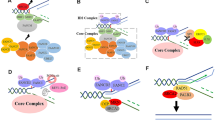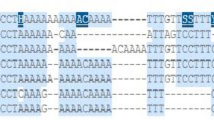Abstract
The incidence of esophageal squamous cell carcinoma (ESCC) is very high in northeastern Iran. Previously, we reported a strong familial component of ESCC among Turkmens, who constitute approximately one-half of the population of this region. We hypothesized that the genes which cause Fanconi anemia might be candidate genes for ESCC. We sequenced the entire coding regions of 12 Fanconi anemia genes in the germline DNA of 190 Turkmen cases of ESCC. We identified three heterozygous insertion/deletion mutations: one in FANCD2 (p.Val1233del), one in FANCE (p.Val311SerfsX2), and one in FANCL (p.Thr367AsnfsX13). All three patients had a strong family history of ESCC. In addition, four patients (out of 746 tested) were homozygous for the FANCA p.Ser858Arg mutation, compared to none of 1,373 matched controls (OR = 16.7, 95% CI = 6.2–44.2, P = 0.01). The p. Lys3326X mutation in BRCA2 (also known as Fanconi anemia gene FANCD1) was present in 27 of 746 ESCC cases and in 16 of 1,373 controls (OR = 3.38, 95% CI = 1.97–6.91, P = 0.0002). In summary, both heterozygous and homozygous mutations in several Fanconi anemia-predisposing genes are associated with an increased risk of ESCC in Iran.
Similar content being viewed by others
References
Adachi D, Oda T, Yagasaki H, Nakasato K, Taniguchi T, D’Andrea AD et al (2002) Heterogeneous activation of the Fanconi anemia pathway by patient-derived FANCA mutants. Hum Mol Genet 11:3125–3134
Akbari MR, Malekzadeh R, Nasrollahzadeh D, Amanian D, Sun P, Islami F et al (2006) Familial risks of esophageal cancer among the Turkmen population of the Caspian littoral of Iran. Int J Cancer 119:1047–1051
Akbari MR, Malekzadeh R, Nasrollahzadeh D, Amanian D, Islami F, Li S et al (2008) Germline BRCA2 mutations and the risk of esophageal squamous cell carcinoma. Oncogene 27:1290–1296
Ali AM, Kirby M, Jansen M, Lach FP, Schulte J, Singh TR et al (2009) Identification and characterization of mutations in FANCL gene: a second case of Fanconi anemia belonging to FA-L complementation group. Hum Mutat 30:E761–E770
Alpi AF, Pace PE, Babu MM, Patel KJ (2008) Mechanistic insight into site-restricted monoubiquitination of FANCD2 by Ube2t, FANCL, and FANCI. Mol Cell 32:767–777
Alter BP (2003) Cancer in Fanconi anemia, 1927–2001. Cancer 97:425–440
Alter BP, Joenje H, Oostra AB, Pals G (2005) Fanconi anemia: adult head and neck cancer and hematopoietic mosaicism. Arch Otolaryngol Head Neck Surg 131:635–639
Callén E, Tischkowitz MD, Creus A, Marcos R, Bueren JA, Casado JA, Mathew CG, Surrallés J (2004) Quantitative PCR analysis reveals a high incidence of large intragenic deletions in the FANCA gene in Spanish Fanconi anemia patients. Cytogenet Genome Res 104:341–345
Couch FJ, Johnson MR, Rabe K, Boardman L, McWilliams R, de Andrade M, Petersen G (2005) Germline Fanconi anemia complementation group C mutations and pancreatic cancer. Cancer Res 65:383–386
Djuzenova CS, Rothfuss A, Oppitz U, Spelt G, Schindler D, Hoehn H, Flentje M (2001) Response to X-irradiation of Fanconi anemia homozygous and heterozygous cells assessed by the single-cell gel electrophoresis (comet) assay. Lab Invest 81:185–192
Futaki M, Yamashita T, Yagasaki H, Toda T, Yabe M, Kato S, Asano S, Nakahata T (2000) The IVS4 + 4 A to T mutation of the Fanconi anemia gene FANCC is not associated with a severe phenotype in Japanese patients. Blood 95:1493–1498
Gordon SM, Alon N, Buchwald M (2005) FANCC, FANCE, and FANCD2 form a ternary complex essential to the integrity of the Fanconi anemia DNA damage response pathway. J Biol Chem 280:36118–36125
Houghtaling S, Timmers C, Noll M, Finegold MJ, Jones SN, Meyn MS, Grompe M (2003) Epithelial cancer in Fanconi anemia complementation group D2 (Fancd2) knockout mice. Genes Dev 17:2021–2035
Howlett NG, Taniguchi T, Olson S, Cox B, Waisfisz Q, De Die-Smulders C et al (2002) Biallelic inactivation of BRCA2 in Fanconi anemia. Science 297:606–609
Islami F, Kamangar F, Aghcheli K, Fahimi S, Semnani S, Taghavi N et al (2004) Epidemiologic features of upper gastrointestinal tract cancers in Northeastern Iran. Br J Cancer 90:1402–1406
Joenje H, Patel KJ (2001) The emerging genetic and molecular basis of Fanconi anaemia. Nat Rev Genet 2:446–457
Kalb R, Neveling K, Hoehn H, Schneider H, Linka Y, Batish SD et al (2007) Hypomorphic mutations in the gene encoding a key Fanconi anemia protein, FANCD2, sustain a significant group of FA-D2 patients with severe phenotype. Am J Hum Genet 80:895–910
Levitus M, Joenje H, de Winter JP (2006) The Fanconi anemia pathway of genomic maintenance. Cell Oncol 28:3–29
Li G, Hu N, Goldstein AM, Tang ZZ, Roth MJ, Wang QH et al (2001) Allelic loss on chromosome bands 13q11–q13 in esophageal squamous cell carcinoma. Genes Chromosomes Cancer 31:390–397
Lowenfels AB, Maisonneuve P (2005) Risk factors for pancreatic cancer. J Cell Biochem 95:649–656
Martin ST, Matsubayashi H, Rogers CD, Philips J, Couch FJ, Brune K et al (2005) Increased prevalence of the BRCA2 polymorphic stop codon K3326X among individuals with familial pancreatic cancer. Oncogene 24:3652–3656
Mazoyer S, Dunning AM, Serova O, Dearden J, Puget N, Healey CS et al (1996) A polymorphic stop codon in BRCA2. Nat Genet 14:253–254
McAllister KA, Bennett LM, Houle CD, Ward T, Malphurs J, Collins NK et al (2002) Cancer susceptibility of mice with a homozygous deletion in the COOH-terminal domain of the Brca2 gene. Cancer Res 62:990–994
McCabe N, Turner NC, Lord CJ, Kluzek K, Bialkowska A, Swift S et al (2003) Deficiency in the repair of DNA damage by homologous recombination and sensitivity to poly(ADP-ribose) polymerase inhibition. Cancer Res 66:8109–8115
Medhurst AL, Laghmani el H, Steltenpool J, Ferrer M, Fontaine C, de Groot J et al (2006) Evidence for subcomplexes in the Fanconi anemia pathway. Blood 108:2072–2080
Mirchandani KD, D’Andrea AD (2006) The Fanconi anemia/BRCA pathway: a coordinator of cross-link repair. Exp Cell Res 312:2647–2653
Murphy TJ, Ravi N, Reynolds JV (2008) Treatment options for esophageal cancer. Expert Opin Pharmacother 9:3197–3210
Narod SA (2002) Modifiers of risk of hereditary breast and ovarian cancer. Nat Rev Cancer 2:1372–1375
Nasrollahzadeh D, Kamangar F, Aghcheli K, Sotoudeh M, Islami F, Abnet CC et al (2008) Opium, tobacco, and alcohol use in relation to oesophageal squamous cell carcinoma in a high-risk area of Iran. Br J Cancer 98:1857–1863
Neveling K, Endt D, Hoehn H, Schindler D (2009) Genotype-phenotype correlations in Fanconi anemia. Mutat Res 668:73–91
Ng PC, Henikoff S (2003) SIFT: predicting amino acid changes that affect protein function. Nucleic Acids Res 31:3812–3814
Nookala RK, Hussain S, Pellegrini L (2007) Insights into Fanconi Anaemia from the structure of human FANCE. Nucleic Acids Res 35:1638–1648
Parkin DM, Bray F, Ferlay J, Pisani P (2005) Global cancer statistics, 2002. CA Cancer J Clin 55:74–108
Pearson T, Jansen S, Havenga C, Stones DK, Joubert G (2001) Fanconi anemia A statistical evaluation of cytogenetic results obtained from South African families. Cancer Genet Cytogenet 126:52–55
Pellegrini L, Yu DS, Lo T, Anand S, Lee M, Blundell TL, Venkitaraman AR (2002) Insights into DNA recombination from the structure of a RAD51-BRCA2 complex. Nature 420:287–293
Pourshams A, Khademi H, Malekshah AF, Islami F, Nouraei M, Sadjadi AR et al (2010) Cohort Profile: the Golestan Cohort Study—a prospective study of oesophageal cancer in northern Iran. Int J Epidemiol 39:52–59
Reid S, Schindler D, Hanenberg H, Barker K, Hanks S, Kalb R et al (2007) Biallelic mutations in PALB2 cause Fanconi anemia subtype FA-N and predispose to childhood cancer. Nat Genet 39:162–164
Rosenberg PS, Greene MH, Alter BP (2003) Cancer incidence in persons with Fanconi anemia. Blood 101(3):822–826
Rosenberg PS, Alter BP, Ebell W (2008) Cancer risks in Fanconi anemia: findings from the German Fanconi Anemia Registry. Haematologica 93:511–517
Rozen S, Skaletsky HJ (2000) Primer3 on the WWW for general users and for biologist programmers. In: Krawetz S, Misener S (eds) Bioinformatics methods and protocols: methods in molecular biology. NJ Humana Press, Totowa, pp 365–386
Rudd MF, Webb EL, Matakidou A, Sellick GS, Williams RD, Bridle H et al (2006) Variants in the GH-IGF axis confer susceptibility to lung cancer. Genome Res 16:693–701
Sadjadi A, Malekzadeh R, Derakhshan MH, Sepehr A, Nouraie M, Sotoudeh M et al (2003) Cancer occurrence in Ardabil: results of a population-based cancer registry from Iran. Int J Cancer 107:113–118
Saidi F, Sepehr A, Fahimi S, Farahvash MJ, Salehian P, Esmailzadeh A et al (2000) Oesophageal cancer among the Turkomans of northeast Iran. Br J Cancer 83:1249–1254
Savino M, Borriello A, D’Apolito M, Criscuolo M, Del Vecchio M, Bianco AM et al (2003) Spectrum of FANCA mutations in Italian Fanconi anemia patients: identification of six novel alleles and phenotypic characterization of the S858R variant. Hum Mutat 22:338–339
Semnani S, Sadjadi A, Fahimi S, Nouraie M, Naeimi M, Kabir J et al (2006) Declining incidence of esophageal cancer in the Turkmen Plain, eastern part of the Caspian littoral of Iran: a retrospective cancer surveillance. Cancer Detect Prev 30:14–19
Simard J, Dumont M, Labuda D, Sinnett D, Meloche C, El-Alfy M et al (2003) Prostate cancer susceptibility genes: lessons learned and challenges posed. Endocr Relat Cancer 10:225–259
Smogorzewska A, Matsuoka S, Vinciguerra P, McDonald ER, Hurov KE, Luo J et al (2007) Identification of the FANCI protein, a monoubiquitinated FANCD2 paralog required for DNA repair. Cell 129:289–301
Sunyaev S, Ramensky V, Koch I, Lathe W, Kondrashov AS, Bork P (2001) Prediction of deleterious human alleles. Hum Mol Genet 10:591–597
Tamary H, Bar-Yam R, Shalmon L, Rachavi G, Krostichevsky M, Elhasid R et al (2000) Fanconi anaemia group A (FANCA) mutations in Israeli non-Ashkenazi Jewish patients. Br J Haematol 111:338–343
Taniguchi T, D’Andrea AD (2006) Molecular pathogenesis of Fanconi anemia: recent progress. Blood 107:4223–4233
Tischkowitz MD, Morgan NV, Grimwade D, Eddy C, Ball S, Vorechovsky I et al (2004) Deletion and reduced expression of the Fanconi anemia FANCA gene in sporadic acute myeloid leukemia. Leukemia 18:420–425
Tischkowitz M, Easton DF, Ball J, Hodgson SV, Mathew CG (2008) Cancer incidence in relatives of British Fanconi Anaemia patients. BMC Cancer 8:257
Titus TA, Selvig DR, Qin B, Wilson C, Starks AM, Roe BA, Postlethwait JH (2006) The Fanconi anemia gene network is conserved from zebrafish to human. Gene 371:211–223
Wijker M, Morgan NV, Herterich S, van Berkel CG, Tipping AJ, Gross HJ et al (1999) Heterogeneous spectrum of mutations in the Fanconi anaemia group A gene. Eur J Hum Genet 7:52–59
Wooster R, Bignell G, Lancaster J, Swift S, Seal S, Mangion J et al (1995) Identification of the breast cancer susceptibility gene BRCA2. Nature 378:789–792
Yagasaki H, Hamanoue S, Oda T, Nakahata T, Asano S, Yamashita T (2004) Identification and characterization of novel mutations of the major Fanconi anemia gene FANCA in the Japanese population. Hum Mutat 24:481–490
Acknowledgments
We thank Ms. Safura Kor, Mrs. Goharshad Goglani, and Mrs. Mina Bahrami from the case–control study center (Atrak Clinic) in Gonbad city for helping with study subject recruitment. We also appreciate the kind help of Alexandre Belisle from the Genotyping Platform of the Genome Quebec Innovation Centre from McGill University on performing MassARRAY genotyping of this study and Richard Moore from Genome Science Centre in Vancouver, Canada for implementing 30% of the sequencing of this project. The remaining sequencing was done by Genome Quebec Innovation Centre from McGill University. This study was supported by grants from the Canadian Institutes of Health Research (CIHR) and the Digestive Disease Research Center (DDRC), Tehran University of Medical Sciences (TUMS). We thank Drs. Stephen Meyn and Yigal Dror for helpful comments.
Author information
Authors and Affiliations
Corresponding authors
Electronic supplementary material
Below is the link to the electronic supplementary material.
Rights and permissions
About this article
Cite this article
Akbari, M.R., Malekzadeh, R., Lepage, P. et al. Mutations in Fanconi anemia genes and the risk of esophageal cancer. Hum Genet 129, 573–582 (2011). https://doi.org/10.1007/s00439-011-0951-7
Received:
Accepted:
Published:
Issue Date:
DOI: https://doi.org/10.1007/s00439-011-0951-7




